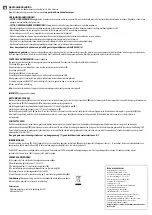
Motus Reference Manual
Page 85 of 146
Version 1.1
29/11/2019
on the 7x2 2.54mm header, see Illustration 65. Two of these pins (GPIO 1 & 2) are also
connected to LEDs on the development board. When using a GPIO in certain input
functions, the LED can cause interference with the signal. In this situation, the LED's
resistor should be removed. When using the GPIO lines for off board functions it is
important to note that these signals are not protected against static charges, over-
voltage or over-current events. Failure to protect the signals may result in damage to
Motus OEM. Other pins on the GPIO header include a regulated 3.3V supply from
Motus that can supply up to 50mA, Motus' reset line and the external voltage input
(VEXT).
14.4
Configuration Switches
The OEM development board contains a DIP switch array that allows the user to route
signals between the USB to serial converter, RS232 converter and GPIO header. The
configuration switches are shown below in Illustration 66 in their default positions. The
default position routes Motus' primary serial port to the USB to serial converter and
has GPIO 3 and GPIO 4 connected only to the GPIO header. Please see Table 20 for the
configuration switch functions.
Illustration 65: GPIO header with functions labelled
















































